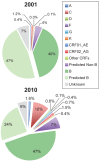Increasing HIV subtype diversity and its clinical implications in a sentinel North American population
- PMID: 24421804
- PMCID: PMC3720001
- DOI: 10.1155/2013/230380
Increasing HIV subtype diversity and its clinical implications in a sentinel North American population
Abstract
Background: HIV-1 is a highly diverse virus; subtypes may exhibit differences in rates of transmission, disease progression, neurotoxicity, antiretroviral treatment failure profiles and accuracy of viral load measurements. To date, the HIV epidemic in Canada and the rest of the developed world has been largely due to subtype B; however, shifts in subtype epidemiology could have significant implications.
Objective: To determine whether there has been an increase in HIV subtype diversity in southern Alberta, Canada.
Methods: All 2358 patients receiving any HIV care between December 31, 2001 and December 31, 2010 were included in a retrospective analysis of subtype prevalence and incidence. In an indexed analysis, subtype trends from 1994 to 2010 were also evaluated.
Results: Between 2001 and 2010, the prevalence of non-B HIV subtypes in patients with a known subtype increased from 7% to 24%. In 2010, the most prevalent non-B subtypes were C (65%), A (11%), CRF02_AG (9.7%), CRF01_AE (4.9%), D (3.9%), G (2.9%) and CRF06_cpx (1.5%). In the indexed analysis, there was an overall proportional increase in non-B subtypes of 2.3% per year. The year-over-year increase in the prevalence of patients infected with a nonsubtype B virus increased from 13% from 1995 to 2002 to 27% from 2003 to 2010 (P=0.01). Incident non-B subtype cases increased from 9.6% to 32.4% over these time periods.
Conclusions: This recent and dramatic shift in HIV strain diversity in Canada is unprecedented and may have important public health, research and clinical consequences.
Historique: Le VIH-1 est un virus très hétérogène, dont les sous-types peuvent différer sur le plan du taux de transmission, de l’évolution de la maladie, de la neurotoxicité, des profils d’échec de traitement antirétroviral et de la précision des mesures de la charge virale. Jusqu’à présent, l’épidémie de VIH au Canada et dans le reste du monde industrialisé est en grande partie attribuable au sous-type B, mais des changements dans l’épidémiologie des sous-types pourraient avoir des conséquences considérables.
Objectif: Déterminer si la diversité des sous-types de VIH a augmenté dans le sud de l’Alberta, au Canada.
Méthodologie: Les 2 358 patients qui avaient reçu des soins du VIH entre le 31 décembre 2001 et le 31 décembre 2010 ont participé à une étude rétrospective de la prévalence et de l’incidence des sous-types. Dans une analyse indexée, les tendances de sous-types ont également été évaluées entre 1994 et 2010.
Résultats: Entre 2001 et 2010, la prévalence des sous-types de VIH non-B chez les patients dont le sous-type est connu est passée de 7 % à 24 %. En 2010, les sous-types non-B les plus prévalents étaient les sous-types C (65 %), A (11 %), CRF02_AG (9,7 %), CRF01_AE (4,9 %), D (3,9 %), G (2,9 %) et CRF06_cpx (1,5 %). Dans l’analyse indexée, on constatait une augmentation proportionnelle globale des sous-types non-B de 2,3 % par année. L’augmentation de la prévalence de patients infectés par un virus de sous-type non-B a augmenté d’une année à l’autre, passant de 13 % de 1995 à 2002 à 27 % de 2003 à 2010 (P=0,01). Les nouveaux cas de sous-types non-B sont passés de 9,6 % à 32,4 % pendant ces périodes.
Conclusions: Ces changements récents et marqués de la diver-sité des souches de VIH au Canada sont sans précédent et pourraient avoir des conséquences importantes en matière de santé publique, de recherche et de clinique.
Keywords: AIDS; Clade; Epidemiology; HIV; Strain; Subtype.
Figures




References
-
- Public Health Agency of Canada. HIV/AIDS Epi Updates: National HIV prevalence and incidence estimates in Canada for 2008. Ottawa: Public Health Agency of Canada; 2010.
-
- Plantier JC, Leoz M, Dickerson JE, et al. A new human immunodeficiency virus derived from gorillas. Nat Med. 2009;15:871–2. - PubMed
-
- Robertson DL, Anderson JP, Bradac JA, et al. HIV-1 nomenclature proposal. Science. 2000;288:55–6. - PubMed
LinkOut - more resources
Full Text Sources
Other Literature Sources

